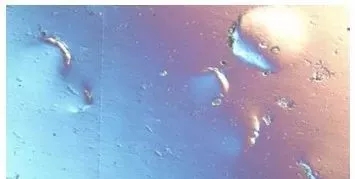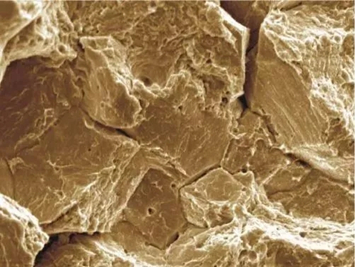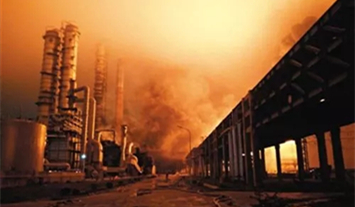- Hydrogen induced cracking, English name Hydrogen-induced cracking (HIC). Hydrogen induced cracking usually occurs in aqueous solutions, which cause embrittlement and cracking of the steel due to diffusion of hydrogen into the matrix of the steel. Hydrogen induced cracking is often caused by accidental factors in the forming or finishing process that cause hydrogen to enter the steel matrix. It is usually affected by three factors, material properties, environmental factors and stress factors.
 Surface bubbling of the sample after hydrogen chargingDuring the Second World War, a fire fighter jet of the Royal Air Force fell from the air due to mechanical failure, and the pilot was killed on the spot. This matter was highly valued by the authorities. All the parts of the crashed aircraft were collected and a special investigation team was set up to investigate the cause of the crash. The plane crash caused the main shaft to break, and many small cracks were found inside the broken main shaft, which was called hairline at that time.Around 1940, Dr. Li Xun, the founder of the Institute of Metal Research of the Chinese Academy of Sciences, began to work on this research at the University of Sheffield in the UK. The prerequisite for solving this problem is how to quantitatively test and analyze the hydrogen content in steel. . Subsequently, Mr. Li Xun invented a hydrogen analyzer for determining the hydrogen content in steel. It turned out that hydrogen caused the fracture of the main axis of the aircraft. Mr. Li Xun has also become the founder of the hydrogen cracking field.High-strength steels containing chromium and nickel are sensitive to hydrogen. Hydrogen with higher carbon content tends to crack more, and low-carbon steel is less prone to hydrogen-induced cracking. Tightly-structured forgings are more susceptible to hydrogen-induced cracking than loosely-formed castings. When the hydrogen atoms penetrate into the steel, the atomic bonding force between the crystal grains is lowered, and the toughness of the steel is lowered.Hydrogen-induced cracking fractures are similar to other brittle fractures, and high-strength materials are prone to occur along the crystal fracture. For low carbon steel, small, underdeveloped dimples are prone to appear on the small facets along the crystal. Some people call it "chicken claw pattern".
Surface bubbling of the sample after hydrogen chargingDuring the Second World War, a fire fighter jet of the Royal Air Force fell from the air due to mechanical failure, and the pilot was killed on the spot. This matter was highly valued by the authorities. All the parts of the crashed aircraft were collected and a special investigation team was set up to investigate the cause of the crash. The plane crash caused the main shaft to break, and many small cracks were found inside the broken main shaft, which was called hairline at that time.Around 1940, Dr. Li Xun, the founder of the Institute of Metal Research of the Chinese Academy of Sciences, began to work on this research at the University of Sheffield in the UK. The prerequisite for solving this problem is how to quantitatively test and analyze the hydrogen content in steel. . Subsequently, Mr. Li Xun invented a hydrogen analyzer for determining the hydrogen content in steel. It turned out that hydrogen caused the fracture of the main axis of the aircraft. Mr. Li Xun has also become the founder of the hydrogen cracking field.High-strength steels containing chromium and nickel are sensitive to hydrogen. Hydrogen with higher carbon content tends to crack more, and low-carbon steel is less prone to hydrogen-induced cracking. Tightly-structured forgings are more susceptible to hydrogen-induced cracking than loosely-formed castings. When the hydrogen atoms penetrate into the steel, the atomic bonding force between the crystal grains is lowered, and the toughness of the steel is lowered.Hydrogen-induced cracking fractures are similar to other brittle fractures, and high-strength materials are prone to occur along the crystal fracture. For low carbon steel, small, underdeveloped dimples are prone to appear on the small facets along the crystal. Some people call it "chicken claw pattern". Hydrogen embrittlement fractureThe hysteresis of hydrogen-induced cracking, the occurrence of hydrogen-induced cracking on welded components is sudden, posing a serious threat to people and property, and needs to be highly valued.
Hydrogen embrittlement fractureThe hysteresis of hydrogen-induced cracking, the occurrence of hydrogen-induced cracking on welded components is sudden, posing a serious threat to people and property, and needs to be highly valued. Explosion accidentHow to eliminate hydrogen in metals is the biggest concern of everyone. Some steels or parts used under special conditions must be dehydrogenated. For example, galvanized parts used on airplanes must be dehydrogenated. Zinc plating on elastic parts and high-strength steel also requires hydrogen removal. In addition to hydrogen, heat is used to drive hydrogen out of the interior of the part. The hydrogen removal effect is related to the hydrogen removal temperature and the holding time. The temperature is high and the time is long and the hydrogen is more thoroughly removed.Usually, the member to be dehydrogenated can be placed in a vacuum oven and treated at a temperature of 200 to 250 ° C for 2 to 3 hours. In addition to hydrogen in hot oil, it has the same effect as hydrogen removal in an oven. It is evenly heated and requires simple equipment.
Explosion accidentHow to eliminate hydrogen in metals is the biggest concern of everyone. Some steels or parts used under special conditions must be dehydrogenated. For example, galvanized parts used on airplanes must be dehydrogenated. Zinc plating on elastic parts and high-strength steel also requires hydrogen removal. In addition to hydrogen, heat is used to drive hydrogen out of the interior of the part. The hydrogen removal effect is related to the hydrogen removal temperature and the holding time. The temperature is high and the time is long and the hydrogen is more thoroughly removed.Usually, the member to be dehydrogenated can be placed in a vacuum oven and treated at a temperature of 200 to 250 ° C for 2 to 3 hours. In addition to hydrogen in hot oil, it has the same effect as hydrogen removal in an oven. It is evenly heated and requires simple equipment.
Plastic Grilles,Plastic Return Air Grille,Plastic Air Vent Grilles,Plastic Ventilation Grilles
Guangzhou Jointair Co., Ltd. , https://www.jointairaccessories.com